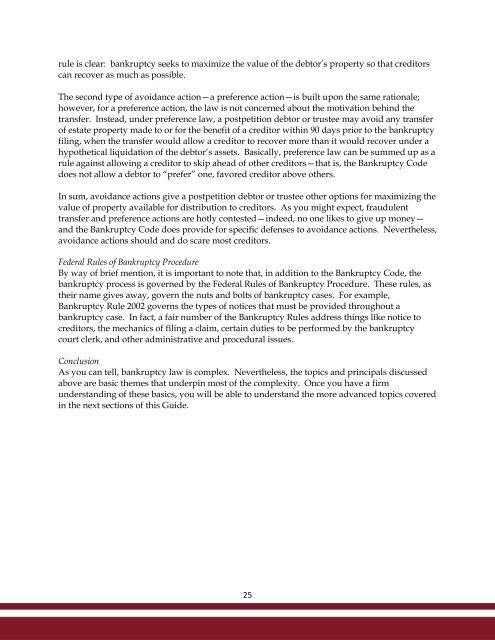Guide-for-Nonprofit-Organizations-Bankruptcy-Issues-FINAL-with-ads
Guide-for-Nonprofit-Organizations-Bankruptcy-Issues-FINAL-with-ads
Guide-for-Nonprofit-Organizations-Bankruptcy-Issues-FINAL-with-ads
- No tags were found...
Create successful ePaper yourself
Turn your PDF publications into a flip-book with our unique Google optimized e-Paper software.
ule is clear: bankruptcy seeks to maximize the value of the debtor’s property so that creditorscan recover as much as possible.The second type of avoidance action—a preference action—is built upon the same rationale;however, <strong>for</strong> a preference action, the law is not concerned about the motivation behind thetransfer. Instead, under preference law, a postpetition debtor or trustee may avoid any transferof estate property made to or <strong>for</strong> the benefit of a creditor <strong>with</strong>in 90 days prior to the bankruptcyfiling, when the transfer would allow a creditor to recover more than it would recover under ahypothetical liquidation of the debtor’s assets. Basically, preference law can be summed up as arule against allowing a creditor to skip ahead of other creditors—that is, the <strong>Bankruptcy</strong> Codedoes not allow a debtor to ―prefer‖ one, favored creditor above others.In sum, avoidance actions give a postpetition debtor or trustee other options <strong>for</strong> maximizing thevalue of property available <strong>for</strong> distribution to creditors. As you might expect, fraudulenttransfer and preference actions are hotly contested—indeed, no one likes to give up money—and the <strong>Bankruptcy</strong> Code does provide <strong>for</strong> specific defenses to avoidance actions. Nevertheless,avoidance actions should and do scare most creditors.Federal Rules of <strong>Bankruptcy</strong> ProcedureBy way of brief mention, it is important to note that, in addition to the <strong>Bankruptcy</strong> Code, thebankruptcy process is governed by the Federal Rules of <strong>Bankruptcy</strong> Procedure. These rules, astheir name gives away, govern the nuts and bolts of bankruptcy cases. For example,<strong>Bankruptcy</strong> Rule 2002 governs the types of notices that must be provided throughout abankruptcy case. In fact, a fair number of the <strong>Bankruptcy</strong> Rules address things like notice tocreditors, the mechanics of filing a claim, certain duties to be per<strong>for</strong>med by the bankruptcycourt clerk, and other administrative and procedural issues.ConclusionAs you can tell, bankruptcy law is complex. Nevertheless, the topics and principals discussedabove are basic themes that underpin most of the complexity. Once you have a firmunderstanding of these basics, you will be able to understand the more advanced topics coveredin the next sections of this <strong>Guide</strong>.25


